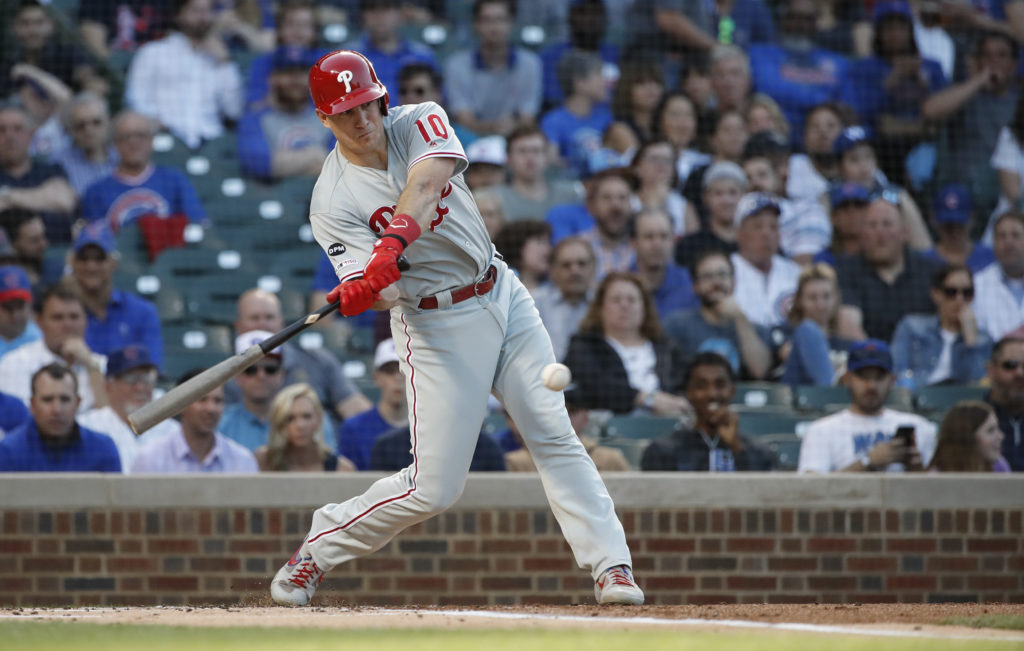Ad Disclosure
The Phillies Need More From a Slumping Offense
By Bob Wankel
Published:

You certainly know by now the Phillies squandered what would’ve been one of their best wins of the season on Tuesday night. You also know the bullpen blew the game when, uh, closer Juan Nicasio couldn’t survive the heart of the Cubs’ potent lineup. Totally unsurprising, but the takes flowed just the same.
A sampling:
“Klentak still can’t build a bullpen!”
“Juan Nicasio needs to be DFA’d!”
“Pat Neshek is __________!”
Went Mad Libs on the last one and let you fill in the blank because I’ve been trying to keep things more professional lately.
Anyway, I was quick to point out the other night during the collapse that the bullpen, while flawed and an arm or two short, hasn’t been a total disaster:
Lot of “bullpen sucks” talk out there right now. Missing Hunter and Robertson—down a few more guys tonight—entered the day with the third-best bullpen ERA in the NL. 🤷♂️
— Bob Wankel (@Bob_Wankel) May 22, 2019
It’s true. The Phillies enter the finale of what has thus far been a frustrating four-game set at Wrigley Field with a 3.78 bullpen ERA—the third-lowest in the National League. If you think that I’m telling you this is a great bullpen, I’m not. But I will say it has been competent—maybe even borderline good, particularly considering the multiple injuries which have caused the prolonged absences of a few key pieces. David Roberston would look good right now, yes?
Phillies relievers have been just average in terms of keeping opposing teams off the bases – their 1.36 WHIP is only 16th – but they’ve stranded 76.3% of base runners while limiting batters to a .248 average. This despite being one of only nine bullpens averaging less than a strikeout per inning this season. That last part is a problem. They need a big arm that can consistently handle late-inning, high-leverage situations, one that can get nasty and blow the doors off opposing hitters. No argument here.
Still, as we digest these back-to-back losses, much of the focus has been on the bullpen and Cole Irvin’s failed start because that’s what we do. We fixate on the outcome, assess the aftermath, and generally assign blame with recency bias. Juan Nicasio was on the mound Tuesday night. Pat Neshek, for whatever reason, wasn’t. Irvin, who was optioned to Lehigh Valley this morning, served up seven runs on 856 ft. of combined homers off the bats of Anthony Rizzo and Alvin Almora, but don’t overlook the culpability of what’s recently been an under-performing offense.
Remember, the lineup was supposed to stack up in marquee games against the NL’s best teams. I mean, look at the names:
Andrew McCutchen. Jean Segura. Bryce Harper. Rhys Hoskins. J.T. Realmuto. I mean, Maikel Franco hitting eighth? Good luck, National League!
Whether or not the offense lives up to the considerable hype remains to be seen, but it didn’t last week at home against the Brewers, and it hasn’t through three games in Chicago. Its two-run output on Tuesday night wasn’t enough for a beleaguered bullpen down its top four arms and followed that quiet performance by letting Cole Hamels off the hook last night. The Phillies put 11 runners on base against Hamels in only four innings and ran him up to 99 pitches but only generated three runs. Irvin wasn’t effective, and you can certainly debate if he should’ve even been allowed to face Almora, but five or six early runs probably changes the game.
Nobody came into this season anticipating a dominant rotation or elite bullpen. What most expected was an offense with enough firepower that it could consistently hide some of the blemishes on a still developing roster. That said, the Phillies have produced only 15 homers this month, ahead of only the eight hit by the Marlins. The Phillies are also 19th in OPS and 24th in slugging percentage during the month of May. That’s not good enough.
Slumps happen, but the growing struggles for Harper, the recent ones for Hoskins, along with the complete lack of production from Odubel Herrera and Maikel Franco is just as responsible for the occasional frustrating loss, if not more, as, say, Juan Nicasio.
For the Phillies to get to where they ultimately want to go, they’ll need to address the arms, sure. But they will also need more consistent output from the bats for it to truly matter.
Bob Wankel covers the Phillies for Crossing Broad. He is also the Vice President of Sports Betting Content at SportRadar. On Twitter: @Bob_Wankel E-mail: b.wankel@sportradar.com